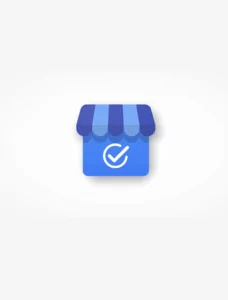
- Red Search
- Resources
- How to Report & Remove Google Fake Reviews
A Business Owners Guide: How to Report & Remove Fake Google Reviews
-
 Daniel Law
Daniel Law
Anybody can write a Google review, so it’s hard to spot which ones are fake. If you’re a small business, you’ll know one if it comes from a person you’ve never met or engaged with before. Though it’s clearer if their profile has one review, dedicated only to your business, with ill intentions.
For most businesses, reviews are crucial to building a positive reputation. One false review could taint your brand, especially from an angry customer with a bone to pick with you. Shady competitors may also use review platforms against you.
What’s worse, most users can’t discern between a genuine customer review and a fake one.
In this article, we’ll uncover why it’s essential and how to deal with these fraudulent critiques on your listing.
Why Fake Google Reviews Matter
Customers see online reviews as an unbiased guide to engage with your brand or not. In fact, almost a third of Aussie consumers weigh online reviews the same as recommendations from close relatives.
However, not all of these are written by customers. Some may use it to promote or slander a brand.
Regardless, fake reviews that purposefully include harmful content can distort how the public views your business, leading to a loss of new sales and revenue. Besides user trust, it also impacts your Google Business Profile’s ability to rank higher in Google Maps.
Consistent appearance of these fake reviews over time results in trust erosion, which leads customers to doubt your ratings and entire brand identity.
Streams of fake reviews commonly originate from three main sources:
- Competitors who seek to harm your rating
- People who dislike your business, however, have never used your products or services
- Disgruntled ex-employees
Since any review instantly goes public upon submission, you just can’t take them down easily. That’s why every business needs to have comprehensive review monitoring and discuss strategies to thwart fake ones through appropriate channels and means.
How to Spot a Fake Review
Is it easy to detect a fake review? In many cases, yes.
The longer you spend analysing reviews, the easier it becomes to identify fake ones based on their consistent structural elements. There are a few telltale signs to discern fake reviews from genuine ones:
- Generic, Vague Feedback: Uses generic phrases without specifics about your product or service
- Inaccurate Details: Misses the particular elements of their buying experience or jotting down any info unrelated to your brand
- Suspicious Profile: Uses basic usernames with no photographs, location information, or posts a flurry of reviews in vastly different localities
- Unrelated Remarks: Promotes other competitors, sounds off-topic, or resembles automated texts
If you receive a sudden influx of these, it’s likely a coordinated effort to manipulate your profile. Some create fake reviews to damage your reputation, while others pursue personal benefits. Unfortunately, these could tip your brand’s credibility, further harming your online image.
While some fraudulent reviewers take things a step further, it’s best to review the customer’s tone if it’s too positive or excessively negative without any supporting information. That way, you can add another layer of screening fake ones to safeguard your online reputation.
To determine whether a review is authentic, you should question whether an actual customer would create such content. Trusting yourself often helps you spot what doesn’t feel real.
Step-by-Step: How to Report a Fake Google Review
Uncovering a fake review on Google requires a simple process that is accessible to all users. This is how you can proceed to handle the situation:
1. Access your business Google account by signing in through the connected Google profile. Through your Google Business Profile Manager, you can perform this action while being signed into your account. Once logged in, navigate reviews option.
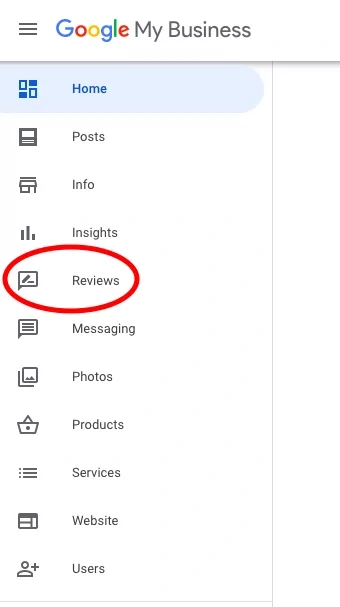
2. When you read through your recent reviews, you should focus on detecting suspicious ones that might be generic praise or contain irrelevant details or have overly harsh criticism without context, because these could indicate potential trouble.
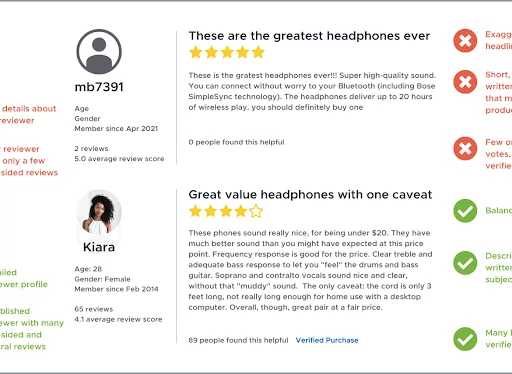
3. You can find a small three-dot icon located next to each review. This icon allows you to access supplementary options for that review.
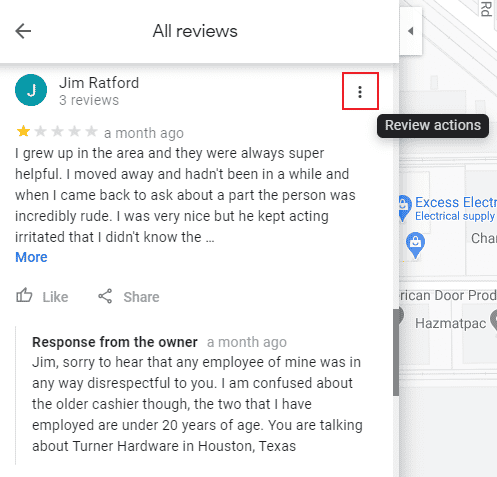
4. To initiate the reporting process, choose “Report Review” from the dropdown list, which will alert Google to assess the review.
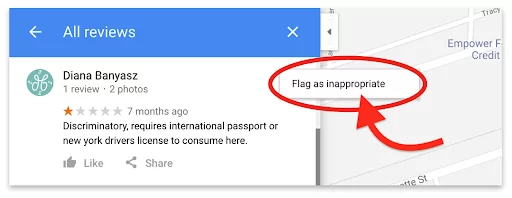
5. Select the specific reason that describes how the review breaches Google’s policy. The review will undergo evaluation by Google after you submit the report. The removal process does not happen immediately, yet it provides essential documentation that enhances your prospects for resolution.
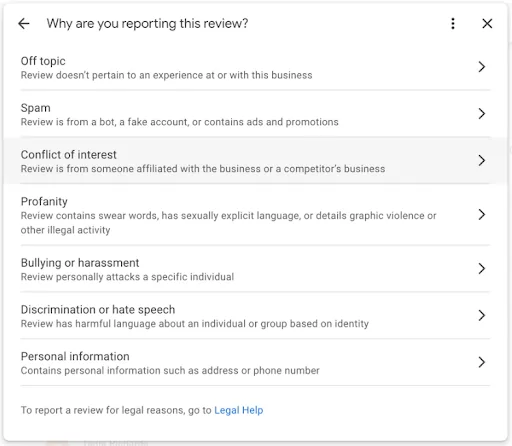
Google will evaluate these reports after submission. You should expect a response within three to five business days, though it could be longer for complicated cases. Google only removes content that violates its content policy and prohibited content guidelines.
Since Google also uses automated spam detection, it can mistakenly remove legitimate reviews aside from what you reported. When reviews inflict substantial harm or multiple review flags result in no action, you should consider advancing to the next level.
For serious problems, you can access Google’s dedicated form for review flagging. Make sure to save your evidence documentation, which includes screenshots and emails, to provide additional support for your claim.
What If Google Doesn’t Remove It? Alternative Options
If a flagged review doesn’t hit the mark for removal, you can only submit a one-time appeal to Google. However, if the false review remains live after these requests, you can take specific measures that prove useful in handling the matter effectively.
Here are a few tips that you can follow:
- Encourage genuine reviews: To drown out fake reviews, get your happy clients to provide honest evaluations. More positive reviews can outweigh the false ones.
- Seek legal advice: If a fake review includes false accusations or defamation, you should seek legal advice to explore the possibility of sending a takedown notice.
- Partner with a trusted team: Managing online reputation requires a substantial time investment. Work with agencies like Red Search for active review monitoring and response management. This ensures your online presence maintains its best possible representation.
Fake reviews can hurt, but with the right methods, you can maintain your brand protection while rebuilding customer trust.
Reporting Fake Reviews to the ACCC
As a business owner, it comes as no surprise that you’ve seen suspicious reviews. Not only are they unethical, but they are also potentially breaking Australian consumer protection laws.
Suppose they appear coordinated or tied to a competitor. In that case, your best response is to inform the ACCC (Australian Competition and Consumer Commission) when you suspect coordinated reviews or links to rival businesses.
We suggest reporting fictitious reviews to the ACCC in the following circumstances:
- Evidence of competitor manipulation: Reviews that seem tactically hurtful instead of authentic
- Review bombing: An acute surge in imitative-looking reviews within a brief timeframe
- Serial abuse of review sites: Fictitious accounts reviewing multiple listings
Though ACCC steps in for fair competition, it focuses on genuine consumer feedback. For instance, an authentic statement such as “the coffee lacks flavour” does not normally violate any rules. It identifies and takes action on false or misleading reviews, as long as they are not actual problems associated with your brand.
If you’re choosing to report via the ACCC, be sure to provide sufficient supporting evidence to support your claim further. We recommend documenting the following:
- Screenshots of all the suspicious reviews
- Dates, user names, and the name of the site where each review was left
- Any contextual information, including trends you’ve noticed or recent competitor activity
Clear reporting doesn’t just boost the potential for the ACCC to take action. It also actively fights against the extensive misuse of online review platforms.
How We Help With Review Management & Local SEO
After dedicating countless hours to building your brand’s image, one unfortunate reality you can face is how easy fake reviews can sweep your efforts under the rug.
At Red Search, we know how tough it is to handle fake reviews, particularly when you’re also building your business. That’s why our team proactively works on review management and local seo.
our clients:
- Track and reply to reviews on every platform that matters with custom, professional messaging
- Earn real 5-star feedback by creating effective review acquisition campaigns that correspond to your customer journey
- Reputation restoration in situations of fraudulent or slanderous reviews, leveraging clever SEO strategies and platform-dependent methods to rebuild brand trust
We help our clients effectively manage their online reputations on Google’s search results, which leads to more high-quality leads, sales, and revenue.
Frequently Asked Questions
Can Google legally remove fake reviews?
Yes. If these reviews are proven to breach Google’s content policy, such as being off-topic, spammy, or conflicting, Google will likely remove them. While this is not a legal consequence, it helps businesses maintain the integrity and trust of their platforms.
How long does it take Google to review a flagged report?
It can take Google several days or weeks to review a flagged report. You can check the status of reported reviews by logging in to your Google Business profile. From there, you can select the “check the status of a review I reported previously” option to tell you if it remains live or has been removed.
What if Google denies my request to remove a review?
It’s fairly common for Google not to remove a review, even if it contains negative remarks. Given it’s a manual assessment, the review remains live because your report is incomplete, vague, or lacks context. After denial of the initial request, you still have the option to appeal the decision.
Can I take legal action against a fake review?
Absolutely, especially if reviews are false, deceptive, or entirely defame your brand identity. If Google doesn’t take down the fake reviews after an appeal, this is your only recourse, though it’s a long shot to ascertain and take the counterfeit reviewers to court.
How many reports does it take to get a review removed?
If the review violates Google’s policy, one report is enough to remove it. Its removal will depend on Google’s own process, so it doesn’t disappear just based on how many users flag it.
Can I remove a negative review if it’s true?
No. As long as they are authentic, relevant, and useful, Google won’t remove them, even if they’re negative. Since they show a genuine customer experience, they comply with the policies and remain live. Your best response to this is to give a professional, constructive reply.
How does review spam affect my local SEO?
Whether positive or negative, spam reviews can harm your local SEO. Google not only reads reviews but also looks into the genuine sentiment about your brand. Given that spam reviews come from profiles with suspicious review activity, it weakens your trust signals. Thus, it can hurt your local search visibility.
Is writing fake reviews illegal in Australia?
Definitely! The ACCC treats fake or misleading reviews as deceptive conduct to tip the balance of fair competition. Australian businesses caught incentivising reviews to promote their own brands or slander others may face substantial fines and legal actions.
Written by


